
The official history of our junior corps and alumni corps: written by Pat Forker, George Lavelle and Bert Lynch, with new additions by Jim Reilly (in grey).
Special thanks to Steve Vickers and Drum Corps World for sharing with us!
The Years Before
There was a time when drum & bugle corps were plentiful across the United States and Canada. Drum corps were organized as a character-building endeavor that would teach people to work together in a common goal and forge lasting friendships. It seems like every VFW Post, American Legion Post, and Catholic Church had one. Bayonne, NJ was no stranger to having a renowned drum corps in its midst. St. Vincent's Cadets (formed 1941) put Bayonne on the map for drum corps audiences across the northeast and were a force to be reckoned with. St. Vincent's traveled across the country to take on the big corps of the day in major competitions, notching wins at the VFW National and American Legion National championships. They were the popular musical organization of Bayonne for decades. But in time, their membership faded and they were forced to close their doors for good in the 1960s. But they left an impact on the memories of Bayonne's residents. A new corps would soon emerge to carry the banner of Bayonne forward.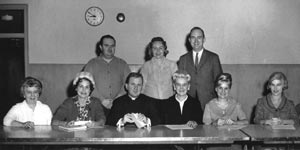
1964
In the spring of 1964, Father Joseph Donovan was assigned as assistant pastor at St. Andrew's parish in Bayonne, NJ. With his appointment, came changes. He remodeled the old school building, morphing it into a youth center, made the basement pine room a point place for dances and recreation and converted the third floor into a widely used meeting place. With the advent of Donovan and being known for having the largest dances in the area, The Catholic Youth Organization's popularity soared.
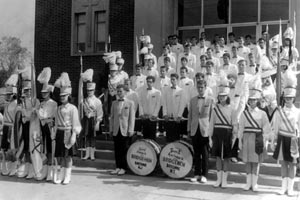
1965
Despite what he had already built, Donovan was thinking bigger. He asked several times if we would be interested in a St. Andrew's drum corps. The idea was finally brought up at a CYO meeting in Jan. 1965, meeting praise and enthusiasm. Several months later, horns arrived, drum sticks were distributed and the color guard began regular gym practices.
Every corps needs a director, an adult to direct traffic, put out fires and lead the troops. Ed Holmes, director since day one, was a surrogate father. It's a known fact that he put plenty of his own money into the corps. He was always there, spending countless hours of time on us. He didn't have kids of his own, but took great satisfaction in the personal achievements of each and every one of us.
Several months later, the Bridgemen came to be. The name was chosen based on the Fort Lee Bridgemen, named for the George Washington Bridge. According to Fr. Donovan, who also favored the Fort Lee athletic teams, St. Andrew's would be named for the Bayonne Bridge; thus giving birth to the Bridgemen.
Under Holmes, interest in the corps was heightened and turnout became so large, horns had to be shared. The first instructors were Dee Kazazian, horns; Dan Raymond, drums and Bob Holton, color guard. Due to job conflicts, Kazazian and Raymond fell by the wayside and were replaced by Gus Wilke, horns and John Iglasies teaching the drum line. Iglasies lasted only two months before receiving a fellowship and was replaced by his mentor, Bobby Thompson in 1966.
Members of the new corps had no musical training as this corps was starting from scratch. But they were a close-knit group of kids who took pride in their neighborhood. Drums were borrowed from the Garfield Cadets (maroon color airbrushed on a wood shell), while the horns were GD single-valve bugles.
The St. Andrew's drum corps made their first appearance at the Bayonne Memorial Day parade in 1965. The color guard marched - minus equipment and uniforms, but this was only the beginning.
Tuxedos were the corps first interim uniform in the autumn of 1965, rented for a parade, while the color guard used uniforms borrowed from Father Nativo of the St. Lucy's Cadets, with flags borrowed from the New York Skyliners.
1966
A fundraiser was put together as a stage presentation called “Heaven's A'Poppin,” featuring corps members and church members, which helped to further draw together support from family and the church community.
The corps made its first field appearance marching an exhibition at a Jets intra-squad game. That day was also the first field appearance of Quarterback Joe Namath.
The corps first true uniform was garnet (maroon) and white colored, made of 100% wool, with silver cumberbund and accessories. The first member jacket was garnet wool with white leather sleeves; the first corps logo was a patch, featuring the Bayonne Bridge, stitched on the back.
August of 1966 marked the Bridgemen's first appearance in the National Dream Contest at Roosevelt Stadium in Jersey City. Because August was prime time for vacationing, the corps performed an exhibition with a mere 20 horns, a handful of drummers and a full color guard. Surprisingly, the performance was clean.
During the winter of 1966-1967, the corps competed in standstills in Staten Island, NY and Montvale, NJ, placing second and fourth. That winter, Bob “Jomba” O'Connor was brought in to work the drum line as only he could.
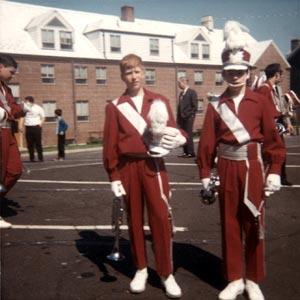
1967
The first true competition for St. Andrew's was a Garden State Circuit contest at Kane stadium in Secaucus, NJ. St. Andrew's took their lumps, gaining experience and a lesson in humbleness, in a number of competitions and finally became worthy of competition. The Bridgemen placed first and won several more contests that year in the Garden State, later placing third in the championship circuit contest. After some hard work and some very good arrangements by Bucky Swan, The Bridgemen won the Garden State circuit in 1968.
As St. Andrew's improved, their feeder corps, The St. Andrew's Kidets did as well. The Kidets, of junior high age, were taught the basics and performed in parades. Started in 1966, the Kidets program was finally starting to pay off, furnishing The Bridgemen with trained, enthusiastic musicians.
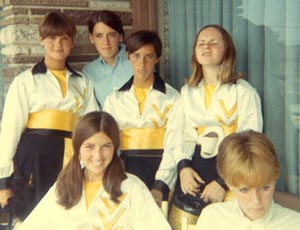
1968
Corps colors changed to yellow, gold, black and white when the Bridgemen purchased uniforms from the recently folded Selden Cadets of Long Island. These attention-getting, dignified uniforms set the new Bridgemen image for many years to come. The drumline and hornline wore a pale yellow jacket with gold accents and a gold shako; a military style in the mold of the West Point Cadet uniform. The color guard wore satin, pale yellow gaucho tops accented with gold chevrons, plus black skirts and black, leather boots, with the same shako. The new look was a morale booster and helped the corps to expect more of themselves.
St. Andrew's played “Step to the Rear,” “Yankee Doodle,” “Grand Old Flag,” “Little Brown Jug,” “Birth of The Blues,” and “What Now my Love” which was standard musical fare of the era.
St. Andrew's continued their ambitious climb within the activity, winning the Garden State Circuit with a score of 71.6 in finals.
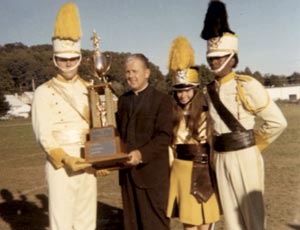
1969
The Bridgemen developed a talent for a brass tonguing technique called triple-tonguing. Begun as a warm-up exercise, it quickly developed into a showpiece and later become a St. Andrew's trademark and a crowd favorite.
After winning the Garden State circuit for the second year in a row in 1969, the corps had moved up through the ranks and began to compete on a national level.
Members of the Bridgemen were passionate about protecting their own: Bert Lynch pointed to “The Fr. Donovan pic from the 1969 Garden State Championship in September, 2 weeks after Wildwood. Right as that picture was being taken a fight broke out with St. Martin's. Both Drum Majors got hit, the girl Peggy Feehan's hair was pulled, the priest slugged somebody, and the fight was on!” Stories of fights between corps were common back then as corps, who molded themselves in the military model, poked fun of their competitors as much as sailors and Marines poke fun of each other.
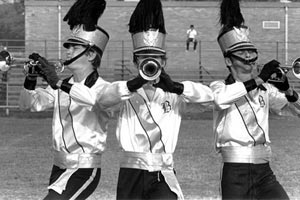
1970
The winter of 1970 brought Hy Dreitzer, arranger for the New York Skyliners, and lots of hard work. Hy Dreitzer was a reknowned arranger/instructor for many hornlines across the northeast “back in the day.” He gave tirelessly of himself and received little or no pay with the simple goal of furthering the activity. His influence gave every corps he worked with an edge. Dreitzer wrote difficult music for the Bridgemen which challenged them to work harder. The horn line practiced several nights a week and all day Sunday under Gus Wilke, to learn to play the music.
That year St. Andrew's competed in Open Class winning a few shows and marching in many parades. Being a local corps, we picked up several jobs in a few hours notice - especially around Election Day - in Bayonne, Jersey City, Hoboken ... anywhere. From Little League parades to political parades, if they had the cash, we had the shoe leather.
The previous set of uniforms were worn out so the corps changed over to uniform tops (made locally) in a white & gold gaucho-style with black pants and a shako featuring an American Eagle. The uniforms would only be used for one season.
This year was a big step up for the corps, as audiences were taking notice of the ambitious yellow & black corps from Bayonne, NJ. In 1970, St. Andrew's placed tenth in the World Open in Lynn, Mass.
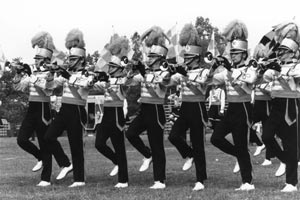
1971
During the 1971 season, we had a slightly smaller horn line and corps. Frank Pacillo was brought in as an assistant instructor, helping clean up the horn line. The same year, Larry Kerchner was brought in to arrange for the horn line. Larry had made a name for himself with the famed Blue Rock of Wilmington, Delaware. He was the “wonder child” of the corps who had great playing ability (playing soprano, mellophone, flugel, baritone, and contra) and went on to write many of their arrangements.
1971 was the toughest season yet. Practicing four nights a week and weekends, the corps was brought further, competing in the U.S. Open in Marion, Ohio. The corps was determined to pull themselves up into the thick of things and would not settle for less.
The corps was able to raise the money to have the Selden Cadets-style uniform professionally recreated: the pale yellow-beige cadet jacket was now worn by horns, drums, and guard; yet the cymbals continued to wear the 1970 gaucho-style tops. The new uniforms gave them a winning look and made the corps recognizable to audiences again.
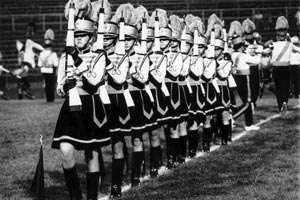
1972
In 1972, St. Andrew's competed locally and toured New England. We also competed in the Midwest, visiting Ohio, Wisconsin, Chicago and Minneapolis. That same year, The Bridgemen earned a charter membership into the newly formed Drum Corps International and place 11th at DCI finals at Warhawk Stadium in Whitewater, Wis. By virtue of its 12th place position in the prelims, they thus had the distinction of being the first corps to compete in a DCI finals.
Jerry Morecraft was promoted to drum major from the baritone line. John Richard also traded in his yellow and black uniform for a white one and stepped up to the podium as drum major. The dynamic opener of “Triumphant March” excited audiences while “Mister Clown” made wide-eyed believers of many with its triple-tonguing passages.
Publisher Steve Vickers recalls: “I couldn't help thinking back to a steamy night in August 1972, as I walked down a sidewalk separating eight lighted practice fields in Whitewater, WI, at the first Drum Corps International Championships. There were eight corps practicing that evening simultaneously and the last one on the left -- as my friend Orlin Wagner and I strolled along like we were window-shopping, -- was a corps with triple-tonguing sopranos and checkered flags. It was the St. Andrew's Bridgemen from Bayonne, NJ, a corps I honestly had never heard of before, given my isolated sort of existence from 1965 to 1987. And at the legendary Warhawk Stadium on that Saturday, August 18, the Bridgemen not only made a name for themselves with their melodious and challenging Kerchner arrangements, but earned an eleventh-place spot in the very first international competition the fledgling DCI organization ran right next to farm land at the edge of town.”
The summer tour of 1972 was dubbed the “two weeks tour” by corps members, St. Andrew's competed in American Legion and VFW Nationals, finishing up the season by winning the American Legion state championship in Wildwood, NJ.
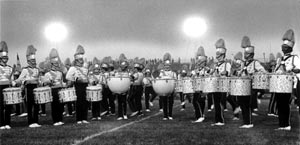
1973
The Bridgemen enhanced their repertoire for the 1973 season by introducing their trademark opener “William Tell Overture,” followed by “Unsquare Dance” performed in 5/3 time. “My Favorite Things,” “Free,” (featuring the golden tone and range of soloist Ed Irwin) and “Summer of '42” capped off a diverse and imaginative musical show that saw them defend their NJ State VFW and American Legion state championships, secure their first World Open title and earn a 9th place finish at the DCI finals that year.
The drum corps rivalries on the field in the East were intense between the corps and the 27th Lancers, Hawthorne Muchachos, Garfield Cadets, St. Rita's Brassmen, Golden Knights, Polish Falcons and Boston Crusaders. It was all too common to have 2-3 competitions every weekend beginning Memorial Day weekend through mid-September, with parades thrown in for good measure as a required source of revenue.
The St. Andrew's Bridgemen were at the top of their game and 1973 was likely the strongest year of what's referred to as “the shako era.” They were gaining the devotion of fans nationwide who knew they would enjoy a demanding show when the Bridgemen took the field. The triple-tounging sopranos and the clean rifle line (nicknamed the “Dugans” after the popular Dugan girls in the line) could always please an audience.
The two week tours were becoming commonplace by then, enticing the involved youth and chaperones to give up their time and vacations to travel the country by bus, sleep on gymnasium floors, exist on meager morsels and rehearse for hours on end and enjoy every minute of the experience.
By the end of the 1973 season many of the original members had aged out, and other long term members elected to pursue other interests. There was a change in staff as well, with those original instructors not being rehired. This left the corps with an immediate deficit in talent that was only partially supplemented by those feeder corps additions, as well as new members that joined the ranks from other smaller competing corps in the area.
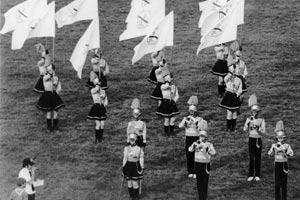
1974
The 1974 show featured the return of some popular charts plus some new ones: “Triumphant March,” “Oye Mama,” “I Can Do Anything Better Than You,” “My Favorite Things,” “Free,” and “William Tell Overture.”
The 1974 season was not as successful as the previous two years. Despite an early season victory at the NJ State VFW Championship, victories that year were few and far between, the level of competitiveness was not as sharp the rest of the season which culminated in a disappointing 26th place finish at the 1974 DCI prelims in Ithaca, NY.
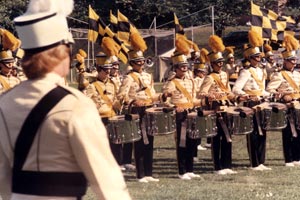
1975
The exodus of talent continued into the next season. Changes in staff were continuous to the point that at the end of the season the corps was basically self-taught. The last place finish at the 1975 Dream Contest was the nadir of the corps existence. The Bridgemen elected not to travel to Philadelphia to compete at the DCI preliminaries. Summoning the very last vestiges of pride, the corps conducted a work weekend prior to the September NJ American Legion competition so as to break a score of 70. That was the only goal accomplished in 1975.
The winter of 1975-76 was one of intense soul searching for the organization. The demographics in the drum corps activity were changing. No longer was St. Andrew's Parish the lifeline for new members, although the Kidets were doing their best to promote their members into the ranks. Increasingly, the corps membership roster was becoming more reliant on new members from not only “out of town,” but out of state.
Our affiliation with St. Andrew Church was waning, as financial hard times across the country was taking its toll on arts programs in many forms. The Bridgemen had to scramble to find new avenues of fundraising.
Ed Holmes and Fr. Donovan, along with the support of the Bridgemen Booster organization, decided to roll the dice and give it one more go to secure a competitive corps for 1976. It was decided that the corps would advertise in local newspapers and drum corps publications and hold an Open House for prospective members. Knowing that publicity alone would not be enough to retain those willing enough to join the effort, a change in direction, show design, uniform and attitude was required.
Behind the scenes negotiations were under way to hire a Program Director that would not only change the direction and fortunes of the Bridgemen, but that of the activity itself.
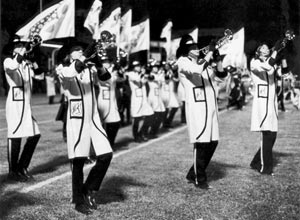
1976
And so it was that the Bridgemen entered the 1976 season resurrected, redefined and ready to challenge the many skeptics that lay in wait.
Bobby Hoffman (a veteran instructor for the Muchachos, Garfield Cadets, and Anaheim Kingsmen) entered the picture as Show Coordinator. Bobby was something of a bohemian who was influenced by Broadway entertainment and wanted to bring that level of showmanship to the activity. He introduced the concept of “Hype!” to the Bridgemen as their new goal: turn up the intensity and max out the show. Bobby also talked about “karma” and said “You get back what you put out.” These hallmark concepts would transform the Bridgemen into performing a demanding show well while “Giving it all ya got.” Members would perform with every ounce of energy they could muster so everyone had a good time. You can read an interview with Bobby Hoffman.
Under the tutelage of Bobby Hoffman, a major overhaul was completed, discarding the cadet uniform of the past and introducing the look of the future in the guise of the long coats and felt hats with scarves, the only commonality being that the traditional colors of black, white and yellow were maintained. The winter season had yielded dividends in the form of increased interest and new recruits from the NY/NJ metropolitan area, as well as those from as far as Tennessee, Florida and North Carolina. Alumni pitched in by working the Friday night bingo at Charity Hall. The percussion section would be directed by the very capable Dennis DeLucia. Dennis had made a name for himself arranging for and instructing the Hawthorne Muchachos. He had a reputation for arranging & instructing to the best of his ability and was an inspired choice to turn around the drumline's fortunes.
The color guard was reborn working under Tom Pratt. The drill instructors, Greg Pych and Jim Messina, worked closely with Hoffman to bring the design on paper to fruition on the field. The wildly abstract “Pollution Flag“ made it clear this corps was progressive and breaking with convention. Then-color guard Captain Claire Kronenfeld explained the symbolism: “Hoffman wanted a flag that represented Bayonne. The blue outlined curves were an abstracted Bayonne Bridge while the other shapes represented pollution in the bay!” Among the guard's innovations was a costume change. During the closer of “One,“ some girls took off the black coats, to reveal a red & silver costume beneath, and formed a Broadway-style kick line! The discarded coats were hung on a hook, placed at the back of horn players' uniforms, to avoid a penalty in the old judging system.
Larry Kerchner, with an influx of renewed talent, had free reign to write a score that offered imagination and modernity to the show that featured a revamped “William Tell Overture,” “NYC Medley,” “Land of Make Believe” featuring the silky smooth soprano solo of Keith Griffin, plus “What I Did For Love,” and “One” from the Broadway hit “A Chorus Line.”
The corps marched in the local Memorial Day Parade wearing pale yellow member jackets instead of uniforms, choosing to save their new look for the home show in Bayonne. New member jackets proclaimed “Bridgemen” on the back instead of “St. Andrew's.”
On the first Saturday in June, at the Tournament of Stars, Veterans Stadium, Bayonne, New Jersey, the 1976 corps made its first appearance in the new attire, entering from the rear sideline with police escort, in front of the home town crowd who were equally shocked at the sight that paraded before them. It took a while for the partisans to adjust to the new visual creation before them, but soon thereafter, it was apparent that the drum corps activity itself had witnessed its own transformation.
The corps struggled at first against the solid and strong competition from its rivals during the first half of the season. Early in the 1976 season, many judges resisted giving good scores to the corps, until finally they had to admit that with their talent level, they could not be denied. By early August they had finished ahead of several DCI finalist contenders, and it wasn't until the week before finals, that talk of qualifying could even be discussed.
At Franklin Field, the corps performed an energized and emotional prelims performance, which landed them in eighth place, and once again restored the corps to the rank of finalist. For those remaining DCI veterans still in the ranks from the Whitewater days, the wait in the entrance tunnel before the corps 1976 Finals appearance was nothing short of a sense of redemption. On the video of the corps' DCI Finals performance, laughing can be heard from some in the audience who were seeing the outrageous yellow and black uniforms for the first time. The corps was lined up on “Side One” to start the show “Off The Line,” in the old drum corps style. As the timing gun went off to begin the show, the corps yelled “Hype!” and let loose a spirited performance of the challenging “William Tell Overture“ to show them what the Bridgemen were made of. The sixteenth note runs played at double forte was astounding. At the end of the opener, no one in the crowd was laughing anymore; wild cheers and applaud heralded a new age for the corps from Bayonne as well as the activity! The roar of acceptance permeated the stadium and the corps responded in kind, adding the signature “faint” to cap their sixth place 1976 DCI Finals performance.
In the upcoming months Fr. Donovan would be reassigned from St. Andrew's and be named pastor at St. John the Evangelist, Bergenfield, NJ. Shortly after the announcement was made, the corps and the parish ended their affiliation. Fr. Donovan saw the corps that he started return to the national competitive arena, and for the “kids” who grew up with him through the ranks of the Kidets and Bridgemen, we were sorry to see him depart, having been our biggest supporter in both good times and bad.
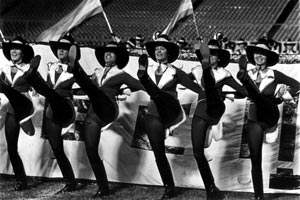
1977
The corps moved away from high leg lifts and snap turns, steering the corps away from the activity's military roots toward a smoother, gliding movement. The “Rainbow Flags” were introduced by the color guard and were later wrapped around the chrome drums for colorful impact. Diane Brady became Color Guard Captain and first donned the white coat. Lower brass member Pat Forker played the part of a traffic-ticket-writing cop with a STOP sign during “NYC Medley.”
The Bayonne Bridgemen were serious title contenders in 1977. The corps' show started off with “Chiquita Banana” (“Yes We Have No Bananas”) drum solo, along with “Pagliacci” as the opener, complete with the operatic tragic clown in tow. Jim Brady, arguably one of the finest horn players in drum corps history, was the featured solo soprano. The Bridgemen won the World Open and DCI East titles, before heading out west to tour enroute to Denver.
After their announced 3rd place prelims performance, several members were singled out by DCI personnel, with the full support of some DCI member corps directors, where the persons under scrutiny were declared ineligible subjecting the corps to disqualification. The Bridgemen sued DCI to contest the disqualification on the grounds that there was no intent to have an overage member march beyond their 21st birthday, since the corps had replacement members on tour to take the spots of those members in question on the day prior to their birthday. A compromise was reached by which the Bridgemen were allowed to compete in the 1977 DCI finals.
The day of DCI finals in Boulder, CO was a painful one for the Bridgemen as no one knew how this would turn out. But lawyers for the Bridgemen found a loophole in DCI rules that allowed the Bridgemen to take the field. The audience's resistance was met with Bayonne tenacity as the corps unleashed a powerful performance in the face of adversity. By show's end the crowd was roaring their approval and the Bridgemen proved they were one of the strongest corps in contention that night.
Their score and placement would not be recognized in the DCI annals. But years later, the disqualification was rescinded and the Bridgemen are now listed as finishing in 4th place in 1977.
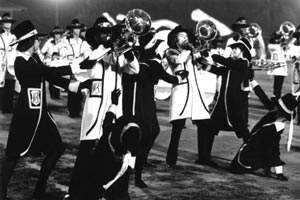
1978
The stain of disqualification was difficult enough to bear, but it was uncertain if the Bridgemen could recover from such ignominy. The Hawthorne Muchachos could not fully recover from their disqualification in 1975 and never again approached that same level of championship contention. Again the members went back to that endless well of inherent pride, and wanting to prove their critics wrong as well to restore their hard earned good name, the Bridgemen returned in 1978 and finished in 5th place, the highest placement that year for an eastern drum corps.
New brass-colored, two valve OLDS bugles were purchased as well as white-shelled Ludwig drums. Jim Jordan stepped up to the podium and donned the all-white uniform for the first of three seasons. The opener of “Ritual Fire Dance/Sabre Dance” demonstrated the power of the hornline as well as the up-and-coming drumline. Jim Brady's golden tone and amazing range in his soprano solos helped make the corps a must-see event. The color guard changed to dance shoes to keep up with the demanding dance moves and choreography; small black tents at the front sideline allowed for a costume change. The color guard blazed a trail in the activity by moving away from militaristic movement in favor of fluid, dance movement. The assymetric drill move during “Hymn to the Last Whale“ was one of the first of its kind on the field, opening the door to a new style of visual show. The Bridgemen “Shuffle,” a dance move by the hornline and color guard (originated by Tom Pratt and Mike Mercandante) was introduced in the drum solo and became a perennial favorite with audiences for years to come.
Spanish Dreams was their trademark number in the repertoire that year, along with the Bridgemen Shuffle, blue cloaked rifle line and endless hyped innovations. At the end of the 1978 season, Ed Holmes retired as Director. Ed had been the only Director the corps had known since its founding in 1965. Although Ed and his wife never had children of their own, he always made it clear to the membership that they claimed 128 children when asked. Jack Dames, another Bayonne native and long time drum corps fan, succeeded Ed as Director and served in that capacity through 1981.
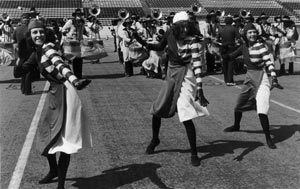
1979
The Bridgemen had a rough start in 1979, but worked hard to climb back into the thick of things. The on-field antics and irreverant attitude of the Bridgemen were showcased at the National Dream Contest in Jersey City when a rainy, mud-soaked day was turned into a fun-filled festival. While some corps elected not to wear their uniforms, the Bridgemen went on without pants, but still wearing their trademark coats, and won over the audience with a spirited performance!
1979 introduced “Gene, Gene the Dancing Machine” and the Andrews Sisters to the field of drums and bugles. That year's tour took the corps south to Birmingham, AL along with the vestiges of the Northern Army of the Potomac to witness a uniquely Bridgemen rendition of the “Civil War Suite,” where by chance the “rebels” emerged victorious in the Heart of Dixie and a sixth place finish, moving up three spots from ninth place in prelims.
The souvenir table was a great fundraiser for the corps, sporting designs like “Banana Power” and other fan favorites. Unfortunately someone in Birmingham also noticed the Bridgemen's popularity with fans, running out of the stadium with a day's souvie profits.
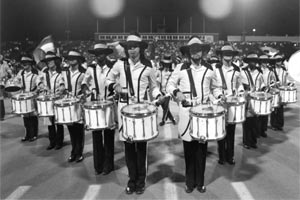 1980
1980“Thunder and Blazes” led the parade of circus animals onto the field in 1980, along with our mascot “Birdie” (color guard member Bernadette “Bernie” Bracero wearing a yellow, red, and blue costume). The drum solo of “The Pursuit of the Woman with the Feathered Hat” broke new ground in technical demand and showmanship while “In The Stone” would be remembered as an all-time crowd favorite. “Big Noise From Winnetka” and the return of “Civil War Suite,” rounded out this amazing show that still stands out after all these years. Jim Prime stepped up as brass caption head (Prime later made a name for himself with The Garfield Cadets and Star of Indiana).
The Bridgemen wrested their fifth World Open title, dueling the 27th Lancers for eastern supremacy and keeping close tabs on the Blue Devils with the Spirit of Atlanta in hot pursuit. The DCI finals saw the top four corps separated by less than 2 points, the Blue Devils emerging victorious, 27th Lancers a few tenths behind in second, the Bridgemen placing third, their highest finish in DCI Finals history. The Bridgemen drum line won their first of three successive high percussion awards that year with hopes high for things to come in 1981. Drum Captain Donald Mindiak led a line of drummers filled with a fiery determination to win. Instructors Bob Dubinski and Pat Scollin were important parts of the drumline's success. Their discipline, motivational abilities, and emphasis on technique with perfection helped set in motion a 3-year Bridgemen drum dynasty in DCI.
The 1980 Bridgemen were at the zenith of their popularity. They knew how to have fun, but had the tenacity to work hard to achieve their goals. Many words are synonymous with “the Bananas” in their best years: unique, groundbreaking, zany, outlandish. Some say they revolutionized the activity, while others resisted their show style and influence on other corps shows. But one thing was certain: The Bridgemen were out to give any audience a good time by connecting with them and performing an accessible show anyone could relate to. The music, uniforms, wicked drumline, and gimmicks they're remembered for were secondary to The Bridgemen Attitude that people remember fondly: a reckless commitment to entertaining.
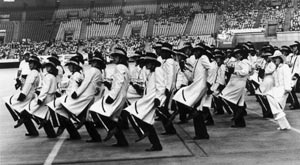
1981
After a very successful 3rd place finish in 1980, there were high expectations for the corps in 1981. Having missed a win at DCI finals the previous year by just tenths of a point, Bobby Hoffman was determined to make a run at the title. But disagreements between Bobby Hoffman, the Board of Directors, administration, and support staff on how to accomplish this, hobbled the lofty goal. The one factor that contributed to an underachieving 1981 season can be attributed to a change in corps chemistry. Gone were those members who had been with the corps when it was Saint Andrew's. In their place were members who had come to the Bridgemen from other corps, taught different methods as to those familiar with the Bridgemen way. This culture gap led to repeated internal disagreements among the members and between staff members. This had a pronounced effect on the corps and its performance on the field. Arguably more talented than the 1980 corps, it just didn't have the same Bridgemen magic of the previous 4 years.
New yellow coats were purchased for the 64-man hornline because the 1976 coats were showing their age. Al DiCroce stepped in as brass caption head. Baritone Brian Law joined the brass staff, staying on for several years as a horn instructor.
The corps kept half the show from 1980 and replaced the Civil War Suite with West Side Story. Inconsistent performances were common for the corps in 1981. It was at the DCI Midwest regional held in Whitewater Wisconsin that the corps was bested for the first time since 1976 by the Garfield Cadets. The 0.5 point victory emboldened the Cadets to purposely march by the Bridgemen buses and revel in delight. This act as well as the appearance of an impaled banana caricature on their food truck at the 1981 CYO Nationals served to motivate the corps and enable others to resolve their differences. The Cadets did not beat the corps again that year.
The Bridgemen put on a show before the show even started. The corps would diagonally enter the field in a box formation doing the Bridgemen “knock.” Suddenly everyone jumped around and let mayhem ensue for 16 counts, then the box snapped back into formation at Count 1, moving the box backfield while doing the “knock” in unison. The crowd's enthusiasm was deafening!
The corps finished 5th in prelims at the DCI Championship, held in Montreal, beating Phantom Regiment by 1 point. Finals were at a different site: Montreal's Olympic Stadium, which had a dome that badly muffled the hornline and turned the audience's conversations into a dull roar. Somehow the electricity that was always there between the audience and the Bridgemen was squelched. In finals, the corps did a lackluster performance losing to Phantom Regiment by .005. The corps had a .1 penalty due to a shoe coming off a member. It was a fitting way to end what had been described as a disappointing season. The percussion section, which had been the strength of the corps throughout the whole year, had the biggest highlight of the year by winning their 2nd high drums trophy. The drumline, which was even better than the 1980 year, was near the top in ever show they were in.
A highlight from 1981 was the corps winning their 5th World Open title (1973, 1977, 1978, 1980, & 1981). It would also be the corps' last title of any kind.
After the year was over, Jack Dames who became the 2nd director in corps history, resigned.
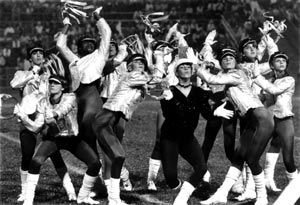
1982
The Bridgemen drumline's popularity and supremacy in the activity helped Dennis Delucia to seal an endorsement deal to obtain a new set of black-rimmed Slingerland drums with brass trim.
As the 1982 season came, gone were those members who had caused some of the internal friction of the previous season. The new rookies coming into the corps were excited to be Bridgemen and understood what it took to be a member of the Bridgemen. The members attitudes were great, with the rallying cry “The Magic Is Back.” The magic was certainly back on the field.
The color guard was now outfitted with tight red & silver uniforms that allowed them to perform the athletic dance steps asked of them. The opener of “Shaft” showcased the raucous enthusiasm only the Bridgemen could bring to the field. The production number of “Sophisticated Ladies,” featured large tables that the color guard girls danced on in perfect unison. Soprano Kevin Serfass stealthily played the demanding solo in “It Don't Mean A Thing” that seemed to be coming from the black-clad color guard Captain Beth's horn! A popular publicity photo that year featured soprano George Lavelle atop the large table, snapping his fingers. The hypnotic drum solo of “Black Market Juggler” introduced more percussion voices with the roto toms and showcased the fast hands of our intense drumline. “Broadway Medley” featured a dynamic wedge moving forward during “New York, New York“ a la The Skyliners. This was a show for the members to perform and have fun with. Audiences loved this show!
The corps looked like it was headed towards a top 6 finish as Championship neared, but a so-so performance at prelims placed the corps in 9th place behind the Freelancers. True to Bridgemen style, they came out in finals to give the fans their money's worth, performing their best show of 1982. At the end of the show the corps put in the Bridgemen faint, then got up and ran off the field. The place went nuts!!!
This great show and the percussion winning high drums for the 3rd year in a row, moved the corps up 1 spot past the Freelancers for 8th place. This was the first time since the corps became “the Bananas” that they were out of the top 6; a six year feat had come to an end. It didn't matter to the members. After all the problems that the corps had in 1981, it was fun to be a Bridgemen again.
The percussion line of 1982 was unbelievable. Their score at Championship that year was 19.5. This tied the Hawthorne Muchachos for the highest drum score ever at Championship. At a show in Pittsfield, Massachusetts, the drums played a 1-tick show. Which in the day of the tick system, that was unheard of. Their score that day was 19.8 out of 20, which was the highest score ever for drums in the day of the tick system. The drumline was in year 3 of their 4-year dynasty. This line of 1982 is considered by many to be the best during this run.
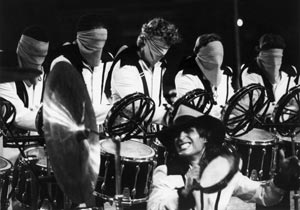
1983
Many changes happened during 1983 for the corps and for drum corps in general. Bobby Hoffman, the architect of “the Bananas,” and long time brass arranger Larry Kerchner were replaced with Dave Bandy and Frank Dorittie. The staff also wanted to change the corps on the field. Gone would be the gimmicks that people were so used to and in its place a show that would be more sophisticated. At the same time, DCI had decided to do away with the tick system. In its place was an opinionated system. Both of those decisions would be fatal for the corps until midseason. At the first show in Lynn, Massachusetts, the corps scored a 47.15, which was at the time the lowest score the corps ever received.
Dave Bandy sought to make the Bridgemen style more palatable to judges. But membership was declining from its peak years earlier. Still, we were chock full of lively people happy to be here. The show featured the driving tempo of “Caravan” as the opener that featured a baritone quartet with John Riccardi and Jerome Kimbrough. Then “Waiting for Godot” introduced a latin flavor to the show. Dennis Delucia's “Black Market/The Juggler” drum solo again challenged the drumline to new heights.
The corps is in the history books, as being the corps who had the lowest score 47.15 to start the season and still make DCI finals.
The judges did not know where to put the Bridgemen in the new system. One night they had the corps up on some corps then down on others. This “up and down” was by many points. The low of this happened at the DCI Midwest Championship held in Whitewater, Wisconsin, where disaster always struck the corps. Here the corps failed to make the cut, placing 13th, losing to the Geneso Knights by 2.5. This was the first time since 1974 that the corps missed a finals show of any kind. The next night in Rockford, Illinois, the corps beat the Knights by 4 points, a 6.5 point turnaround in one night.
At midseason, with the sophisticated approach not working on the field, the staff changed half the show by putting in some gimmicks and making the show more appealing to the audience. Jeff Dawson taught us the words to “So what you see is what you get, & you ain't seen nothin' yet!” which we sang coming on the field. A couple of days after the Midwest injustice, two judges came and talked to the corps and explained and apologized for the inconsistency of the system and promised that it would not happen again. The members who had dealt with all of this had the heart of a champion (which most all of the Bridgemen corps had, except for 1981), and kept working hard to make sure the corps would make finals.
At the DCI championship, held in Miami that year, the corps did a good job in prelims. The corps came in 11th place ahead of the Sky Ryders and Crossmen, who the corps had battled all year. In finals, the corps put in some more gimmicks, with the Bridgemen Bird making a return by jumping out of a big present box. Also, the snare drummers put on blindfolds and played on roto toms during the fast part of their drum solo, never missing a beat. At the end of the show there was a ripple Bridgemen faint.
The corps stayed in 11th place. Lost in the mix was the Color Guard's 3rd place finish. The guard led by a young gentlemen by the name of Scott Chandler, (he of Blue Devil fame) had their highest placement for a Bridgemen guard. The percussion's quest for a 4th high drum trophy ended with a 3rd place finish. This was mostly due to the corps going on so early in finals; they didn't get the score they deserved. Many believe that they were the best line in the country and should have won the title. But the Blue Devils drumline maintained their dominance in 1983 to capture high drums. This ended a remarkable 4-year percussion dynasty. This dynasty was led by their caption head and arranger Dennis DeLucia, and his right hand man Bob Dubinski. It was also supported by many other instructors and alumni who came back to help continue this dynasty for 4 years.
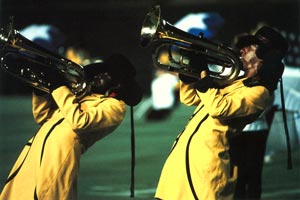
1984
1984 saw another chapter of the corps come to an end. Many of the members, who had grown up in the feeder corps the Kidets, and were from Bayonne, had decided to move on to other things in their lives. This left only a handful of people left from the great town of Bayonne, a complete reverse from when the corps was started when everyone was from Bayonne.
Once again it was decided to have the corps do a more sophisticated show instead of the gimmicks that was tried unsuccessfully in 1983; this type of show was received with more success in 1984. The show was “Overture” from “Merrily We Roll Along,” “Boggie Down,” “Aw Quitcher Moanin'” (drum solo), and “The Civil War Suite,” which the corps did in 1979 & 1980. An iconic moment of the show was in the closer, when a giant American Flag was unfurled while the color guard spun their blue umbrellas with white stars. Ray Fallon, who had taught the corps in 1977 & 1978, was brought back to run the horn program. With Ray at the helm, and the talent base better then years past, the hornline became a big asset. Their highlight of the season was at a show held at the Meadowlands, at that show they won high horns for the first time since 1980, beating 1984's finalists Cavaliers, 27th Lancers, & Crossmen. The corps battled 27th Lancers all year as both were fighting for one of the last spots for finals. At the DCI Midwest regional, again held at Whitewater Wisconsin, the corps missed the cutoff again as it had in 1983, placing 13th. The corps that knocked them out was the Velvet Knights, whose philosophy was that of the Bridgemen: ENTERTAINMENT!!!
This year was also the first year the corps had their own food bus. It turned out to be a huge mistake; most of the food was left out and became rotten, leaving the corps hungry. One night on tour the corps came in from a hard day of practice and each member was served a plate of popcorn. Not only were the members in a fight to make finals, but now they did not have food. The organization could not replace the food that was lost, due to the financial troubles it was having. Other corps were helping out sending food over to the corps. It left the corps in an unstable state in the eyes of DCI.
When the corps reached DCI prelims that year in Atlanta, they knew they couldn't give up. The corps did a good enough performance to get into finals, or so they thought. As the corps was getting their picture taken, their score was announced and they realized they did not make it. Shock and disbelief came over the corps. They ended up in 14th place losing to the Velvet Knights, who basically now had the identity introduced by the Bridgemen, and to the Troopers. It was a sad ending to a season that the members had fought so hard to make successful.
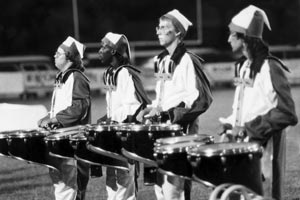
1985
The rumor mills falsely claimed year after year that the Bridgemen had disbanded and it was finally catching up to them. Plus speculation about money problems meant the corps was no longer drawing the level of talent and cross-country members they once had.
Most of the staff from the 1984 season, including Dennis DeLucia, who had been with the corps since 1976 were gone. Dennis would later have success with many other corps which included the Star of Indiana & Crossmen. The board brought back Bobby Hoffman. They hoped that he would be able to create the magic again as he had when he was with the corps form 1976-1982. The show that year was a great show for the Bridgemen. The show was “Christmas in July,” complete with a great big Christmas box that the corps would start the show under, hornline and drumline in elf outfits and the guard in Mrs. Claus outfits. They had snowball fights, Santa Claus, and even Baby New Year. After the first half of the show, the corps changed out of their getups and back into the yellow coats. The 2nd half of the show was “Come On Dance With Me,” followed by “Imagination.” This corps did not have the guns to pull it off. If this show was done any other year, it would have succeeded. It was not to be. This year the corps was not very competitive. The corps finished near the bottom at every show. At a show in Waterbury Ct., the corps scored a 32.40, which is the lowest score the corps ever received. It is ironic that this would be where (just the previous year) the corps won their last show ever.
The corps hit bottom at DCI East, in Allentown Pa, where the corps had one of if not the greatest moments in their history in 1977 when they won the DCI East title. This year the corps had one of its worst performances ever. The corps placed 25th out of 26th. At DCI championship in Madison, the corps placed in 26th place, which was last place. The corps took the field for prelims right after the Madison Scouts, who were having a strong year. The board had made the wrong decision by not giving the staff of 1984 another year. The outcome might have been a lot better had the staff from 1984 returned.
After the 1985 season, it was decided the corps would go inactive for the 1986 season.
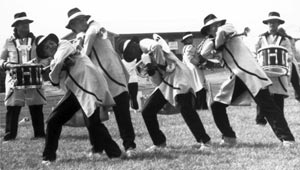
1987
After a year's absence the corps started up again. With a new staff and a new financial backer, the corps set out to capture the magic it once had. The show this year was in 2 parts. The first was a recap of the Bridgemen's greatest hits, the 2nd part was “High Crime,” “Mozaik,” and “Motown.” Crowds liked the show and were very happy that the corps had made a reappearance. A meeting that was held in April that year, with administration and staff to make a decision on what division to compete in, decided the fate of the corps. The corps had only 65 members and could not compete against open corps of 128. The right decision would have had the corps compete in A-60 and go against corps the same size and re-establish the corps instead of going against the big boys and getting slaughtered. The decision was made to go Open. Ego rather than reality prevailed, the attitude that the Bridgemen should not lower themselves by being anything less than an Open corps won the day. This proved to be devastating to the corps. They were soundly defeated in every open competition. At DCI East, the corps finished in last and finished 23rd out of 24th in Quarterfinals. When you add the top 12 corps who were already into Semi's, the corps actually placed 35th. If the decision had been decided on the other path, to compete A-60 the corps might have had a chance to be Champions of A-60. Due to the corps not coming out the year before and not being a member (falling out of top 25 in 1985), the corps was forced to compete in the A-60/A-90 tour now know as the Division 2 & 3 tour. On this tour, the corps beat corps that would wind up in the top 3 of A-60. This would be the Bridgemen's last show performance at DCI.
This year was also the first year the corps had its own buses. The buses purchased from Avante Garde, proved to be another bad mistake made. In West Virginia, one bus that was parked came out of park and rolled down a hill into a wall. The bus was totaled.
The other bus would catch fire when in park and when the gears were not shifted right to go forward. This was a regular routine for the corps. These problems contributed to the corps losing much needed practice time. This year was a very tough year on its members. What got the corps through 1987 was heart.
1988
The corps started out with better numbers than the year before, having close to 85 kids showing up at the first camp. This did not last as over the next few months the numbers started to dwindle and they started to have money problems again. The executive director informed the staff at the end of the February camp that he would be folding the corps. The staff pleaded with him to give it one more month and give the kids a chance to obtain the money that was needed to go on. He gave in and at the March camp, money was brought in by the members who, with the staff, thought they had done enough to have the corps continue. It was also decided that the corps would compete in A-60, a decision that was made a year too late. At the end of camp, the corps marched in the West Orange St. Patrick's Day parade, where the camp was held. It was here that the Bridgemen made their last public appearance, because the executive director folded the corps the next day. He just forgot to tell the members or the staff.
What a sad ending for the greatest entertaining corps of all time. A corps who was ahead of its time. A corps who changed drum corps for the better. The Bridgemen will always be remembered as: Entertainers, Innovators, a corps who just had fun, & the rebels against the drum corps establishment. But most important, it was a corps that always had heart. Heart that was started in 1965, and continued all the way to the end in 1988. This look back at the Bridgemen is dedicated to 3 gentlemen, whose visions helped make this a great drum corps. The first 2 gentlemen are Edward Holmes & Father Joseph Donovan, who had a vision to start a drum corps out of the Saint Andrew parish and who gave the corps its heart and soul. They also made it a family atmosphere. The 3rd gentleman is Bobby Hoffman, whose vision was to take the corps to absolute craziness and create a corps whose main purpose was to entertain audiences.
HYPE!!!!
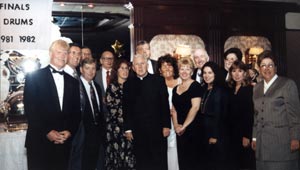
Many veterans of the junior corps, member and instructor alike, mourned the passing of the junior corps. But its legacy lived on with those who taught corps or band to embrace the philosophy of the Bridgemen. The corps approach to showmanship lived on in several corps like the Velvet Knights, Masquerade, and years later: the Jersey Surf. Yet the irreverant approach didn't work well for all corps; some had to move away from that level of crowd appeal to move up in the judges standings.
A tribute to great drum corps by the Archer-Epler Musketeers in April 1991 included a soprano soloist in a Bridgemen yellow coat, standing next to a Garfield Cadet. And at the end of his solo, the Bridgemen fainted!
oprano player George Lavelle teamed with his father to start a new drum corps in Bayonne called the Raiders. George was their first corps director and served that role for years. His efforts were acknowledged by DCI when he was voted Division III Director of the Year in 1996.
A 30th Anniversary Gala in 1995 reunited many members and staff who had a golden opportunity to get reacquainted. There was a large turnout by the drumline trophy winners of the 1980s, who had kept the Bridgemen close to their hearts all these years.
Unbeknownst to veterans of “The Bananas,” many veterans of the St. Andrew's years stayed in contact and met at The Venice Bar & Restaurant in Bayonne on the first Saturday of the new year for a big bash. Several of them and their families took annual cruises together. One year, they had garnet baseball caps made up with the 1966 Bridgemen logo, and shirts silkscreened with “I'm With Bert!” while Mr. Lynch's shirt proclaimed, “I'm Bert!”
2002
Bridgemen veterans came together again at a New Jersey Drum Corps Hall of Fame gala as two of our own, founder Father Donovan and instructor Bob Holton, were being honored for furthering the activity and New Jersey drum corps. The Bridgemen veterans who assembled that evening had an opportunity to relive the exciting days of their youth and pledged to stay in contact. They met in Bayonne in the coming months and discussed trademarking the name Bridgemen to protect our legacy. As friendships were rekindled and these veterans came to enjoy each other's company anew, a resolve formed to keep this going permanently. In November 2002, the Board of Directors was formed with nine members, 3 members representing each of our three eras (1960s, 1970s, 1980s): Steve Schaller (President), Pat Forker (Vice President), John Riccardi (Secretary, fundraising, recruitment), Tom Kowalak (Treasurer), Claire Kronenfeld, Jim Jordan (AA President), plus Ken “Dondi” Donovan, Bobby Farrell, and George Lavelle. The Bridgemen Organization, Inc. was formed of this nucleus of dedicated veterans with the Alumni Association under its wing.
2003
Alumni of different eras met regulary to discuss how best to keep this fraternity alive. Gary Karpinski, Bob Haley, Doug Kuenzel, and Ruth Ann Cooper entered as officers of the Board of Directors when others resigned. Nancy DuCharme, newly retired from a management position on Wall Street, oversaw our finances and finessed the tiny details of day to day operations. Steve Schaller launched the official website at bridgemen.com to give veterans and fans of the junior corps a place to come visit and reminisce about our glory days. The Age of the Internet meant that people could get information and entertainment 24 hours a day. It featured a large picture gallery and some news about the new corps. Plus the forum gave many the opportunity to communicate with each other for the first time in years.
They began kicking around the idea of forming a new drum corps. They discussed starting a new junior corps, but abandoned this idea because of the crushing funding involved and how it might affect recruiting of other struggling corps in the state. They discussed a one-time performance of a mega corps, at the level of the 1994 27th Lancers Alumni Corps, but again this didn't seem the best fit for us. Since an effort by Doug Luberts in the late 1990s to restart the drum corps had been unsuccessful, this idea was clearly a gamble.
The Board of Directors appointed George Lavelle to conduct a feasibility study to determine if this crazy notion could work. George's experience as a Bridgemen member and founder of The Raiders made him the ideal candidate to tackle this project. George labored over the logistics and crunched the numbers for months before making his presentation to the Board: Yes, it COULD be done. The money could be raised and there are many veterans who had already declared their interest in marching again. But would we get enough people to commit the first year to make the effort worth it or would it be a disappointment?
2004
It was decided early on that the corps would create a sound financial foundation before a single rehearsal was ever held. Financial strain had caused untold hundreds of corps to close its doors; this was a minefield we were determined to steer clear of this time around. The call for donations and fundraisers went out; it was slow going, but in time the treasury would start its climb out of the red. We had a friend in Donald Mindiak, a veteran of Dennis Delucia's drumline, who was now Vice President of Bayonne Community Bank (BCB). His financial advice plus the efforts of many hardworking veterans would help us chart a course to afford new equipment and uniforms.
The founding fathers/mothers of the new era brought their business acumen to the group and delegated the responsibilities of who would take on what. Some were inexperienced at what they took on, but were determined to follow it through as best they could.
A new website was launched at bridgemen.info (with Greg Moore as the new webmaster) and the site heralded the approaching Open House; an invitation was sent in the mail to get the good word out. Father Doherty of St. Andrew welcomed us back with open arms and enthusiastically agreed to let us use the church and school for practice facilities in the off season. As Open House for the 2005 Season drew near, management looked ahead with nervous anticipation of the turnout we'd get. As over 100 people crammed into St. Andrew, management was relieved that there was indeed a desire by alumni and newcomer alike to recreate the magic that was The Bridgemen. Rodney Pierce walked around selling 50/50 tickets for the first time as Executive Director George Lavelle outlined his bold plans for the future. George was determined not to put together a heavy practice schedule that might burn out members, as had happened to a few other Alumni Corps that tried to grow too quickly. Our rally cry of “Alive in 2005” would soon become reality.
October 2004 saw the first rehearsal of the new era and strong turnouts in all three sections. Members traveled from as far away as Texas, Florida, South Carolina, Canada and the midwest to get a piece of the action. Some of our valued talent from our golden years returned to set the course for us: Dennis Delucia, Bob Dubinski, Pat Scollin (drums), and Larry Kerchner (horns) returned to the fold. And former members Dennis Argul and Brian Law (horns) rounded out the brass staff. Guard would now be cheographed by veteran Matt Hurley, assisted by veterans Claire Kronenfeld and Nancy DuCharme. Soon the corps got to work and waded into uncharted territory. Though some of our members had continued to pick up instruments or equipment to perform, others hadn't in many years. So our musical choices were geared toward less challenging music on which we could build. “Battle Hymn of the Republic” and “Stars & Stripes Forever” were chosen with our first performance in mind: the Memorial Day parade in May 2005 which would mark the 40th Anniversary of the corps first appearance. “In The Stone” was also chosen because it was a perennial favorite among members and fans alike. In the months to follow, we got to know each other better and soon mischievous personalities carved out a niche for themselves.
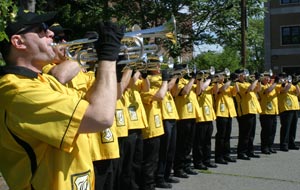
2005
Drum Majors Mike Rogers, Jim Jordan, and John Richard took command of tempos and proved themselves in leading rehearsals. Gary Karpinski became the new drum sargent, John Riccardi was responsible for the hornline. 134 Drum Corps World photos of the Bridgemen & Kidets premiered on our website. Rehearsals continued once a month into the spring when it was decided we would add Thursday night rehearsals at the Joyce-Herbert VFW Post near St. Andrew. Post Commander Glen Flora, a veteran of the drumline and a Vietnam veteran, had welcomed us in with open arms and given us a second home. These additional rehearsals helped our commited local members to improve. In the weeks before the parade we began rehearsing outdoors and marching around in a block at Don Ahern Veteran's Stadium to prepare for the long parade in store for us. The city of Bayonne was abuzz for months about the Bridgemen's appearance in the parade for the first time in decades. We didn't intend to leave them disappointed.
The big weekend finally arrived and we rehearsed on Saturday with unbridled zeal. The next day was the Alumni Picnic where we performed in our new bowling shirt uniforms (yellow for the drumline and hornline, black for the color guard) with baseball caps. It was an affordable uniform for a fledling corps that still projected unconventional and unique. And maybe a bit irreverent. Alumni both in and out of uniform were gripped by this momentous occassion when our beloved Bridgemen were indeed a reality again for all to see. Our outdoor concert was a hit and paved the way for a wonderful picnic with family and friends. The next day brought us together again for the parade down Broadway in Bayonne. The enthusiasm of members was contagious and is evident in the corps picture taken on Memorial Day 2005. But the most cherished memories were still on the horizon that day. Father Doherty led the procession down Broadway in Bayonne. From the moment we entered the parade, the town was waving, screaming, and clapping. We stopped in front of the old bank on 9th Street and gave an emotional performance for our alumni and supporters that was filmed by WABC-TV and broadcast nationally. The parade route was thick with people anxious to see and hear the Bridgemen again after so many years of silence. The Bridgemen were back and this was just the beginning.
The 2005 performance schedule was to end with Memorial Day weekend. But Bridgemen members who had reestablished friendships and forged new ones, were not content to let it end for a few months and didn't want the party to end! The Bridgemen Color Guard spent the summer learning a guard show, choreographed and taught by Matt Hurley, and performed it with pizzaz at DCA finals weekend in Scranton in the Alumni Color Guard category.
A few dozen horn players and three drummers also continued rehearsing through the summer, intending to compete as a Bridgemen Mini Corps. With the changing of DCA Rules, management elected not to compete, but instead to keep this group together for other planned performances. We performed with Bayonne High School's band at the September 11th dedication ceremony and made new friends (and met some future members). But perhaps our most memorable performance was at the Open House in October 2005, for the 2006 season. From the opening chords of “Pagliacci,” the wide-eyed crowd knew they were in for a treat. Rob Hunter's solo and the ensemble's performance made a strong impression on the audience. For many who were “on the fence,” their commitment was sealed that night. Executive Director George Lavelle made the bold announcement that we would bring back the uniforms that most members and fans were clamoring for: the classic yellow and black coats would be recreated for the following season.
A month later, Alumni and families at our 40th Aniversary Gala opened were regaled by the Mini Corps. The walls of St. Andrew's gym were decorated wth corps memorabilia, uniforms, flags, and large photos (courtesy of Mary Cerreta) to commemorate our junior corps years. The night was a huge hit with veterans and newcomers alike as we celebrated the night away.
Many corps members had proven their determination to get back in the game and improve themselves for the next leg of the journey. George Lavelle saw the level of dedication happening around him and asked the section leaders if they thought members would be willing to accelerate the 3-year plan to a 2-year plan: the answer was a resounding “Yes!” The Bridgemen would return to the field a year sooner than planned. During the winter, the Board of Directors held several meetings and elected John Riccardi to the office of President of the Organization at one of them. Fundraising was a concern again after the decision was made to recreate the costly yellow and black coats from Hoffman's years.
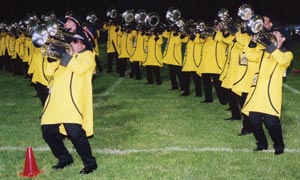
2006
George Lavelle declared, “In 1964, Father Donovan began the dream; in 2006, 'The Dream Continues.'” The Bridgemen buckled down for a heavier rehearsal schedule and began to learn new music and routines that echoed our junior corps' glory days. The Bridgemen Alumni were back as an exhibition corps but maintained their time honored goal of reaching their potential as performers.
Our founder Father Donovan, now Monsignor Donovan, passed away in February 2006; the 2006 show was dedicated to his memory. Diane Sadowski (rifle) and Antoinette Zbylut (flag) were appointed Color Guard Captains of their sections to help lead the charge.
The 1980 Bridgemen were voted into the “DCI Top 12 Countdown” where one of our greatest shows was displayed on the silver screen nationwide. The spotlight was again on the Bridgemen and what we would pull off as an alumni corps.
The dress rehearsal (in our new yellow and black coats) in Manville, NJ and the Memorial Day parade of 2006 were turning points that put us on the road to recapturing the level of showmanship that the Bridgemen were renowned for. The comraderie and mischief that was such a part of our characters flourished again as we became more comfortable with our instruments, equipment, and marching. A new bridgemen.com was rolled out as Kevin Serfass took over as webmaster; he reworked the layouts, multimedia galleries, and code to give it a dynamic overhaul that enhanced the user experience.
Management, volunteers and boosters (notably the Bernard, Ascough, and Fernandez Families) came together to plan out the “Tournament of Stars” home show, which would feature The Return of the Bridgemen to the field for the first time in 19 years. The night of June 10, 2006 arrived with sleepless members struggling with a torturously long wait up the hill before entering Don Ahern Veteran's Stadium. After 9pm, the Bayonne Police squad cars finally began rolling forward with their sirens going; Executive Director George Lavelle had thoroughly planned this moment to recreate a memorable moment from 30 years earlier when the new Bridgemen made their debut, out to shake the activity to its foundations. 134 Bridgemen members took the field for the ride of our lives. Once the show was underway, it was apparent this was a magic moment for member and audience alike as the adrenaline rush took hold and guided us through a heartfelt, intense celebration of our legacy.
We traveled to Bridgeport, CT next for a much cleaner performance that saw us wake up a sleepy audience who embraced us as consummate showmen. The Jersey Surf show in Wildwood, NJ featured another spirited performance which concluded with us and the Jersey Surf playing “Battle Hymn of the Republic” together; this forged a strong bond between the members and staff. Our pre-show antics in Allentown, PA featured Carl Marsteller running and falling on a fake bass drum that ends up crushed; two volunteers and a stretcher arrived to rescue... the drum! The Bridgemen took the field in Allentown as guests of DCI for the Eastern Classic and gave our all for an audience of 8000 people, thrilling diehard fans and making new converts. The Alumni Spectacular in Rochester, NY was the season closer that featured another exciting opportunity to let it all hang out.
At a Board meeting in September, Business Manager Nancy DuCharme announced that despite the season's expenses (including new uniforms) the corps was practically debt-free. The Board of Directors elected Doug Kuenzel to the Board of Trustees. The Columbus Day parade brought the corps together again, featuring 4-year old Anthony Rubino (Debbie's son) as a mini-me drum major in a white coat! Practices continued from autumn into the winter with a strong December rehearsal, that had a great tournout, as we learned “Ritual Fire Dance/Sabre Dance” and previewed the awesome opener in store for 2007.
With a few years of experience as Bridgemen performers under our belts now, the new Bridgemen were now poised to take on a more challenging show for 2007. The best was yet to come.
About the Authors
Writer for 1964-1972: Bert Lynch marched in the St. Andrew's Bridgemen from 1965 (beginning in the drumline) through 1972 (as a member of the hornline), the New York Skyliners in 1973 and 1974, Bayou City Blues part time from 1992 through 1999, and the Bridgemen Alumni's baritone line of 2005. He now lives in Texas with his wife, Kelly. They have three children and one granddaughter. Bert is a charismatic presence and endeared by all St. Andrew's veterans who know him. Bert's legacy is evidenced every time we sing his creative words to our “corps song.” Back in the St. Andrew's era, Mike Kerwan brought back an Army unit song and Bert came up with his own words to it while on a bus ride with his Bridgemen buddies!
Writer for 1973-1980: Pat Forker grew up in Bayonne, NJ. He joined the St. Andrew's CYO Kidets, feeder corps to the St. Andrew's CYO Bridgemen, in 1967. In 1969, he was promoted to the Bridgemen's horn line where he played baritone through the 1973 season. He marched one show in 1974 and then returned to the ranks of the hornline with the contra bass section through the end of the 1978 season. He is a sales account manager with Lyondell Chemical Company covering the Northeast region of the United States. He and his wife, Jean, live in Cranford, NJ with their daugher, Nellie. Pat is revered as the corps historian and cherishes the lifelong friendships he made during two different eras of the Bridgemen.
Writer for 1981-1988: George Lavelle marched in the St. Andrew's Kidets from 1972-1978. He then marched in the Bridgemen from 1979-1983 as a soprano player. In 1987, he was a marching instructor. Since 1981, he has been a visual instructor, drill designer for numerous marching bands and drum corps. He has written drill for numberous marching bands through the years and works with Bayonne High School presently. Lavelle is the founder and first director of the Raiders from Bayonne, whose philosophy in the early years was like the Bridgemen. For some years, he was a computer operator for BMW North America. He is good friends with Bob Jacobs, Director of the Jersey Surf and Publicity manager for DCI. George and his wife Teresa (an alumnus of the Raiders) have a daughter (Riley) and a son (Ryan) together. George wears several hats as the Executive Director for the Bridgemen Alumni Corps, Drill designer/lead instructor for the marching program, and sits on the Board of Directors.
Most photos courtesy of Drum Corps World; 1964, 1965, 1967, & 1969 photos courtesy of Ken “Dondi” Donovan; 1968 photo courtesy of Debbie Druback-Kowalak; 1975 photo courtesy of Donald “Rocky” Glenn; 1984 photo from 1985 DCI Championship week program book.
Article reproduced with permission of Steve Vickers and Drum Corps World. www.drumcorpsworld.com
First published in “A History of Drum & Bugle Corps, Vol. 2” published by
Sights & Sounds, Inc., copyright 2002-2003. To order this book, go to the
Drum Corps World store page.